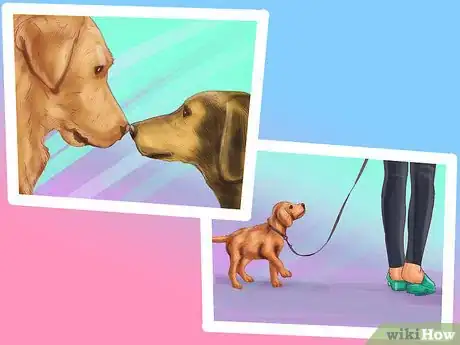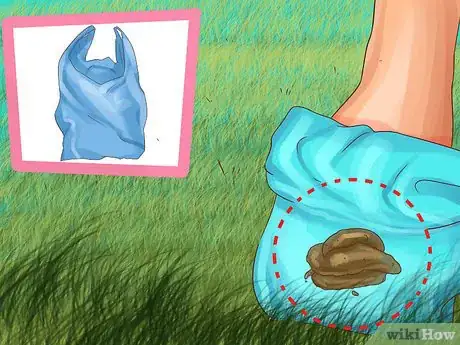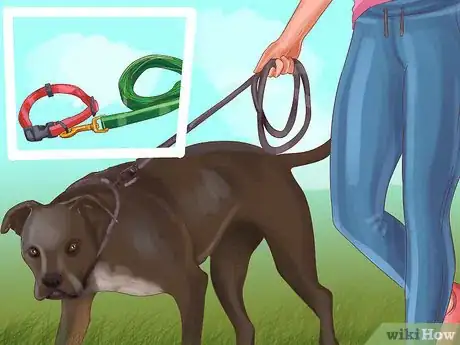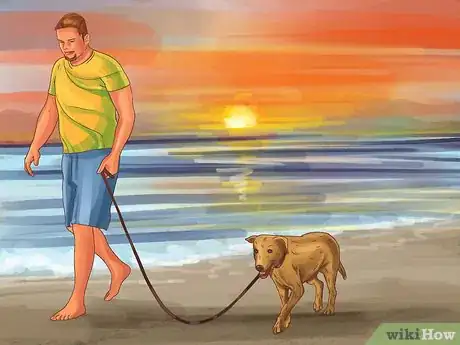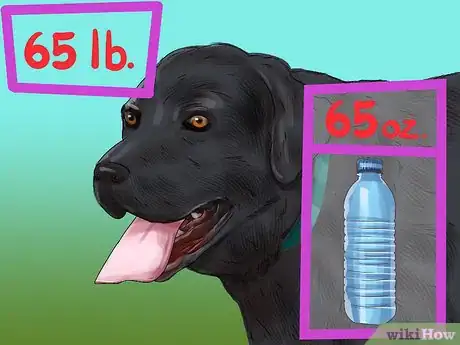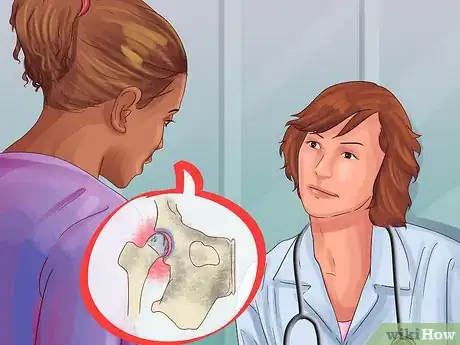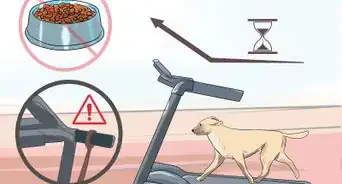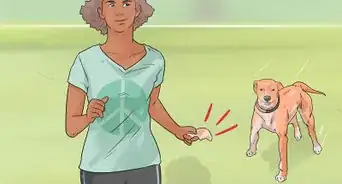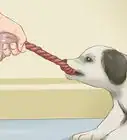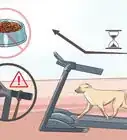This article was co-authored by David Levin. David Levin is the Owner of Citizen Hound, a professional dog walking business based in the San Francisco Bay Area. With over 9 years of professional dog walking and training experience, David's business has been voted the "Best Dog Walker SF" by Beast of the Bay for 2019, 2018, and 2017. Citizen Hound has also been ranked #1 Dog Walker by the SF Examiner and A-List in 2017, 2016, 2015. Citizen Hound prides themselves on their customer service, care, skill, and reputation.
This article has been viewed 15,786 times.
Walking your dog is a fun and relatively simple task. However, depending on where you live, you may need to do a little preparation before you leave home. Before you take your dog out for a stroll, make sure that you have met a few essential preparations, such as bringing along enough food and water. It is also important that you have the correct leash and collar for your dog. Finally, if depending on where you live and what time of year it is, you may need to take special precautions to avoid any weather related injuries. If you keep these considerations in mind before you leave home, you and your dog will have a fun and safe walk.
Steps
Making the Essential Preparations
-
1Train and socialize your dog. When you take your dog for walks, make sure that your dog is properly socialized. This will prevent it from barking and growling at other people and dogs. You should also train your dog to walk beside you and not tug on the leash or pull you.[1] Properly leash training your dog will help you keep your dog safe and under control during your walk.[2]
-
2Wait at least an hour after your dog eats to take it on a walk. Make sure your dog has plenty of time to digest before they exercise; giving them 60-90 minutes is ideal. This will help keep your dog comfortable during the walk and prevent bloat, a dangerous condition that can occur when the stomach twists and can’t let gas out.
- Symptoms of bloat include trying to vomit but not bringing anything up, sudden collapse, or an enlarged stomach.
- If you see any of these symptoms in your dog, bring it to a vet right away.
Advertisement -
3Bring water. You and your dog will need to stay hydrated during your walk, especially if it is a long one. Bring a water bottle for you and your dog. You can carry this water in a backpack or have your dog haul it in a carrying vest.
- Depending on the weather and intensity of the walk, plan for your dog to drink ½ to 1 ounce (14-28 g) of water per pound (1/2 kg) of its body weight. For example, a 60-pound (30 kg) dog will need 30 to 60 ounces (850 to 1700 g) of water.[3]
- If your dog does not drink from a water bottle, be sure to bring a bowl.
-
4Get a few plastic bags. During your walk, your dog will likely have to go to the bathroom. Be sure to bring a couple of small plastic bags to pick up your dog’s feces. Picking up your dog’s mess is not only courteous, it is the law in many places.
- In many locations, failing to pick up your dog’s mess can result in a fine.
-
5Grab a toy. Depending on the length of the walk, you may want to bring along one of your dog’s toys. For example, if you end up in a park or other open area, you can play fetch with a ball or other chew toy. This will help your dog burn off some of its energy and get some extra exercise.
- Toys with squeaker can also help get a puppy's attention if they aren't listening to your commands.[4]
Finding the Right Leash and Collar
-
1Talk to your veterinarian. Before you get your dog, you should ask them what kind of leash and collar you might need. Depending on the type of dog, its temperament and the intensity of your walks, there is a variety of leashes and collars that you will want to consider. If you have puppy, they will also likely recommend that you leash train it.[5]
- Your veterinarian may be able to supply you with the appropriate collar and leash. If not, you should be able to find them at your local pet supply store.
-
2Consider a basic leash and collar. If your dog does not have any obedience issues, this collar is a great option. It allows your dog to walk beside you comfortably and with a limited amount of control. This is the best option for well-trained dogs that have few behavioral issues.[6]
- Remember to walk beside your dog in order to maintain control.
-
3Think about a slip collar. If your dog is young or has issues while walking, try a slip collar. This will give you greater control over your dog and help you correct its behavior if it gets distracted. With a quick and firm tug to the side, you can get your dog’s attention and refocus it on the walk.[7]
- If you are having troubles with a slip collar, consider pairing it with a pack leader collar. This will give you greater control and help you avoid hurting your dog.
- If you are unfamiliar with using a slip collar, talk to your veterinarian before you use the tool.
-
4Purchase a harness. If you want your dog to pull you, you will need to get a harness. This is a great option if you want to roller blade or ride your bike while walking your dog. The harness distributes the weight of pulling across the dog’s entire body, instead of just around its neck.[8]
Walking Your Dog in Inclement Weather
-
1Check the forecast. Before you consider walking your dog, you should always check the forecast. During hot and cold weather, you will need to plan accordingly so that the walk is a safe one for you and your pet. It is also important to check the weather forecast to avoid being caught in a storm or other inclement weather.
- You can check the weather on a television, radio, computer or a weather app on your phone.
-
2Exercise in the early morning or the late evening. During the summer time, you will want to avoid walking your dog in the middle of the day when temperatures are at their highest. Instead, you should walk your dog during the cooler hours of the early morning or late evening. This will help keep you and your dog from being overheated and dehydrated.[9]
-
3Bring extra water. If you have to walk your dog during the day, be sure to bring extra water to drink. You will want to bring the maximum amount of water recommended for your dog. For example, if your dog weighs 65 pounds (30 kg), be sure to bring at least 65 ounces (2 kg) of water.
- Consider having your dog wear a water carrying vest. This will help keep it cool while it walks.
- Pack a spray bottle. Because dogs do not sweat, you may want to bring a spray bottle to mist your dog with water while you walk. This will help dissipate heat from your dog’s body. Be sure to spray the top and bottom of your dog to keep it cool.[10]
-
4Use doggie boots. In many locations, pavement and other surfaces can get extremely hot during the summer months. These hot surfaces can burn your dog’s paws. In order to avoid this, consider training your pet to wear boots that are made just for dogs.[11]
- Your dog can also wear the boots in the winter when it gets cold.
- You should be able to find dog boots at your local pet supply store.
-
5Massage your dog’s joints before the walk if it has arthritis. Many older dogs suffer from arthritis, which is aggravated by exposure to cold. If you know that your dog is arthritic, massage its muscles before the walk, gently bend and flexing the main joints in its legs. This helps warm up the joints and get your dog ready to move.[12]
- You can also talk to your veterinarian about ways to manage its pain. They may recommend medications or techniques that will relieve the pain of arthritis.
- Although you need to walk your dog, think about limiting an arthritic dog’s exposure to extreme cold. An arthritic dog is more likely to slip and fall on ice.
-
6Buy your dog a jacket. One way of protecting your dog from the cold is to buy it a jacket. A Jacket will help maintain your dog’s core temperature and prevent it from getting too cold. These are particularly useful on shorthaired dogs that do not have a thick coat of hair to keep them warm. If your dog is arthritic, a jacket may also help with any joint pain.[13]
- If the jacket gets wet, make sure that you dry it before using it again. A wet jacket will make your dog lose body heat quickly.
- You can find dog jackets at most pet supply stores.
Community Q&A
-
QuestionWhat should you not do when walking a dog?
 David LevinDavid Levin is the Owner of Citizen Hound, a professional dog walking business based in the San Francisco Bay Area. With over 9 years of professional dog walking and training experience, David's business has been voted the "Best Dog Walker SF" by Beast of the Bay for 2019, 2018, and 2017. Citizen Hound has also been ranked #1 Dog Walker by the SF Examiner and A-List in 2017, 2016, 2015. Citizen Hound prides themselves on their customer service, care, skill, and reputation.
David LevinDavid Levin is the Owner of Citizen Hound, a professional dog walking business based in the San Francisco Bay Area. With over 9 years of professional dog walking and training experience, David's business has been voted the "Best Dog Walker SF" by Beast of the Bay for 2019, 2018, and 2017. Citizen Hound has also been ranked #1 Dog Walker by the SF Examiner and A-List in 2017, 2016, 2015. Citizen Hound prides themselves on their customer service, care, skill, and reputation.
Professional Dog Walker Try not to pull back while using any collar. This can hurt your dog’s neck.
Try not to pull back while using any collar. This can hurt your dog’s neck. -
QuestionHow do I make my dog a better walker?
 David LevinDavid Levin is the Owner of Citizen Hound, a professional dog walking business based in the San Francisco Bay Area. With over 9 years of professional dog walking and training experience, David's business has been voted the "Best Dog Walker SF" by Beast of the Bay for 2019, 2018, and 2017. Citizen Hound has also been ranked #1 Dog Walker by the SF Examiner and A-List in 2017, 2016, 2015. Citizen Hound prides themselves on their customer service, care, skill, and reputation.
David LevinDavid Levin is the Owner of Citizen Hound, a professional dog walking business based in the San Francisco Bay Area. With over 9 years of professional dog walking and training experience, David's business has been voted the "Best Dog Walker SF" by Beast of the Bay for 2019, 2018, and 2017. Citizen Hound has also been ranked #1 Dog Walker by the SF Examiner and A-List in 2017, 2016, 2015. Citizen Hound prides themselves on their customer service, care, skill, and reputation.
Professional Dog Walker Walk your dog beside you, which will assert that you are the pack leader. This will also keep your dog from getting ahead of you and running into traffic. If your dog has a slender neck, like a Greyhound, or a breathing problem, like a Pug or Bulldog, slip him into a harness.
Walk your dog beside you, which will assert that you are the pack leader. This will also keep your dog from getting ahead of you and running into traffic. If your dog has a slender neck, like a Greyhound, or a breathing problem, like a Pug or Bulldog, slip him into a harness. -
QuestionWhat is the proper way that I should walk a dog?
 David LevinDavid Levin is the Owner of Citizen Hound, a professional dog walking business based in the San Francisco Bay Area. With over 9 years of professional dog walking and training experience, David's business has been voted the "Best Dog Walker SF" by Beast of the Bay for 2019, 2018, and 2017. Citizen Hound has also been ranked #1 Dog Walker by the SF Examiner and A-List in 2017, 2016, 2015. Citizen Hound prides themselves on their customer service, care, skill, and reputation.
David LevinDavid Levin is the Owner of Citizen Hound, a professional dog walking business based in the San Francisco Bay Area. With over 9 years of professional dog walking and training experience, David's business has been voted the "Best Dog Walker SF" by Beast of the Bay for 2019, 2018, and 2017. Citizen Hound has also been ranked #1 Dog Walker by the SF Examiner and A-List in 2017, 2016, 2015. Citizen Hound prides themselves on their customer service, care, skill, and reputation.
Professional Dog Walker Make sure you train your dog how to walk without pulling, or else it may hurt itself during the walk. It takes time to train a dog to walk properly, but it will be much easier to control.
Make sure you train your dog how to walk without pulling, or else it may hurt itself during the walk. It takes time to train a dog to walk properly, but it will be much easier to control.
References
- ↑ David Levin. Professional Dog Walker & Trainer. Expert Interview. 19 December 2019.
- ↑ https://www.cesarsway.com/dog-training/walking/6-tips-for-mastering-the-dog-walk
- ↑ https://www.active.com/parenting-and-family/articles/how-much-water-does-a-dog-need-while-running
- ↑ David Levin. Professional Dog Walker & Trainer. Expert Interview. 19 December 2019.
- ↑ https://www.cesarsway.com/dog-training/training-tools/choosing-the-right-leash-and-collar
- ↑ https://www.cesarsway.com/dog-training/training-tools/choosing-the-right-leash-and-collar
- ↑ https://www.cesarsway.com/dog-training/training-tools/choosing-the-right-leash-and-collar
- ↑ https://www.cesarsway.com/dog-training/training-tools/choosing-the-right-leash-and-collar
- ↑ https://www.cesarsway.com/dog-care/weather-care/top-summer-tips
About This Article
Before you start walking your dog, make sure it's properly socialized with other dogs and trained to walk on a leash so that it doesn’t get out of control. If your dog has just eaten, wait at least 60 to 90 minutes before going for the walk so it has time to digest and is more comfortable while walking. When you head out for your walk, remember to bring a few small plastic bags to pick up any poop your dog leaves along the way. You should also have some water handy so your dog can stay hydrated. For more tips from our Veterinary co-author, including how to find the right leash and collar for your dog, read on!
